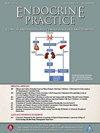Effects of Teprotumumab and Role of Human Leukocyte Antigens Markers in Patients With Thyroid Eye Disease
IF 3.7
3区 医学
Q2 ENDOCRINOLOGY & METABOLISM
引用次数: 0
Abstract
Objective
To evaluate the effects of teprotumumab on ophthalmologic and biochemical findings and assess potential genetic markers for response to treatment.
Methods
This is a retrospective study. Participants were 18-76 year old. All subjects were treated with teprotumumab. The primary outcome was the change in proptosis before and after teprotumumab treatment. Secondary outcomes include change in other ophthalmic measures and thyroid laboratory tests. Human leukocyte antigens (HLA) markers were analyzed for response to teprotumumab.
Results
Twenty-six patients were included in the final analysis. There was a significant decrease in thyroid stimulating immunoglobulin and thyrotropin receptor antibody levels and significant increases in glycated hemoglobin A1c, fasting glucose, and total T3 levels. There was also significant reduction in proptosis, clinical activity score, retinal nerve fiber layer thickness, ganglion cell analysis, and intraocular pressure. HLA haplotypes were distinct between responders and nonresponders, with HLA-DRB3 02:02:01G, HLA-DRB4 neg, and HLA-DQB1 02:01:01G demonstrating better response to teprotumumab and HLA-A 23:01:01G strongly correlating to nonresponse.
Conclusions
Patients with both acute and chronic thyroid eye disease treated with teprotumumab had a significant reduction in thyroid stimulating immunoglobulin and thyrotropin receptor antibody levels and improvement in proptosis, clinical activity score, retinal nerve fiber layer and ganglion cell analysis thickness, and intraocular pressure. HLA may predict responders vs nonresponders. Further studies with longer duration and larger population comparing teprotumumab with steroids or other immunomodulatory agents (tocilizumab, rituximab, etc) may be helpful.
特普鲁单抗对甲状腺眼病患者的作用以及HLA标记物的作用。
目的评估替普鲁单抗对眼科和生化检查结果的影响,并评估TED反应的潜在遗传标记:这是一项回顾性研究。参与者年龄为 18-76 岁。所有受试者均接受了替普鲁单抗治疗。主要结果是特普罗单抗治疗前后突眼的变化。次要结果包括其他眼科指标和甲状腺实验室检测的变化。此外,还分析了人类白细胞抗原(HLA)作为对替普鲁单抗反应的标记物:26名患者被纳入最终分析。TSI和TRAb水平明显下降,HbA1c、空腹血糖和总T3水平明显上升。突眼、临床活动评分(CAS)、视网膜神经纤维层(RNFL)厚度、神经节细胞厚度(GCA)和眼压(IOP)也有明显下降。HLA单倍型在有反应者和无反应者之间存在差异,HLA-DRB3*02:02:01G、HLA-DRB4*neg和HLA-DQB1*02:01:01G对替普鲁单抗的反应更好,而HLA-A*23:01:01G与无反应密切相关:接受替普鲁单抗治疗的急性和慢性TED患者的TSI和TRAb水平均显著下降,突眼、CAS、RNFL和GCA厚度以及眼压均有所改善。HLA可预测应答者与非应答者。进一步开展持续时间更长、人群更多的研究,将替普鲁单抗与类固醇或其他免疫调节剂(托珠单抗、利妥昔单抗等)进行比较,可能会有所帮助。
本文章由计算机程序翻译,如有差异,请以英文原文为准。
求助全文
约1分钟内获得全文
求助全文
来源期刊

Endocrine Practice
ENDOCRINOLOGY & METABOLISM-
CiteScore
7.60
自引率
2.40%
发文量
546
审稿时长
41 days
期刊介绍:
Endocrine Practice (ISSN: 1530-891X), a peer-reviewed journal published twelve times a year, is the official journal of the American Association of Clinical Endocrinologists (AACE). The primary mission of Endocrine Practice is to enhance the health care of patients with endocrine diseases through continuing education of practicing endocrinologists.
 求助内容:
求助内容: 应助结果提醒方式:
应助结果提醒方式:


